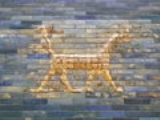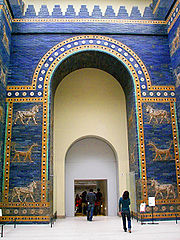
Sirrush
Encyclopedia
The mušḫuššu is a creature depicted on the reconstructed Ishtar Gate
of the city of Babylon
, originally dating to the 6th century B.C. It is a mythological hybrid, a scaly dragon
with hind legs like an eagle
's talons and feline
forelegs. It also has a long neck and tail, a horned head, a snakelike tongue and a crest.
The Akkadian
name loosely translates to "splendor serpent."
The variant sir-ruššu is due to a mistransliteration in early Assyriology.
 Mušḫuššu is associated with Marduk
Mušḫuššu is associated with Marduk
.
It gave rise to the Lernaean Hydra
of Greek mythology
and ultimately to the modern Hydra constellation.
Bel and the Dragon
, a deuterocanonical Biblical
text, relates a story that Koldewey thought involved a sirrush. In a temple
dedicated to Bel (Nebuchadnezzar's god), priests had a "great dragon
or serpent
, which they of Babylon
worship
ed."
Daniel
, the protagonist of the Book of Daniel
, was confronted with this creature by the priests in the apocryphal text. (see Additions to Daniel
) They challenged him to match his invisible God against their living god. Eventually, Daniel poisoned the creature.
, who discovered the Ishtar Gate in 1902, seriously considered the notion that the sirrush was a portrayal of a real animal. He argued that its depiction in Babylonian art was consistent over many centuries, while those of mythological creatures changed, sometimes drastically, over the years. He also noted that the sirrush is shown on the Ishtar Gate alongside real animals, the lion
and the rimi
(aurochs
), leading him to speculate the sirrush was a creature the Babylonians were familiar with.
The creature's distinctly feline front paws seemed incongruous, and gave Koldewey some doubt. However, In 1918 he proposed that the iguanodon
, (a dinosaur with birdlike hindfeet) was the closest match to the sirrush (Sjögren, 1980).
Cryptozoological speculation regarding sirrush was also presented by
Adrienne Mayor
and Bernard Heuvelmans
.
Ishtar Gate
The Ishtar Gate was the eighth gate to the inner city of Babylon. It was constructed in about 575 BC by order of King Nebuchadnezzar II on the north side of the city....
of the city of Babylon
Babylon
Babylon was an Akkadian city-state of ancient Mesopotamia, the remains of which are found in present-day Al Hillah, Babil Province, Iraq, about 85 kilometers south of Baghdad...
, originally dating to the 6th century B.C. It is a mythological hybrid, a scaly dragon
Dragon
A dragon is a legendary creature, typically with serpentine or reptilian traits, that feature in the myths of many cultures. There are two distinct cultural traditions of dragons: the European dragon, derived from European folk traditions and ultimately related to Greek and Middle Eastern...
with hind legs like an eagle
Eagle
Eagles are members of the bird family Accipitridae, and belong to several genera which are not necessarily closely related to each other. Most of the more than 60 species occur in Eurasia and Africa. Outside this area, just two species can be found in the United States and Canada, nine more in...
's talons and feline
Felidae
Felidae is the biological family of the cats; a member of this family is called a felid. Felids are the strictest carnivores of the thirteen terrestrial families in the order Carnivora, although the three families of marine mammals comprising the superfamily pinnipedia are as carnivorous as the...
forelegs. It also has a long neck and tail, a horned head, a snakelike tongue and a crest.
The Akkadian
Akkadian language
Akkadian is an extinct Semitic language that was spoken in ancient Mesopotamia. The earliest attested Semitic language, it used the cuneiform writing system derived ultimately from ancient Sumerian, an unrelated language isolate...
name loosely translates to "splendor serpent."
The variant sir-ruššu is due to a mistransliteration in early Assyriology.
History

Marduk
Marduk was the Babylonian name of a late-generation god from ancient Mesopotamia and patron deity of the city of Babylon, who, when Babylon became the political center of the Euphrates valley in the time of Hammurabi , started to...
.
It gave rise to the Lernaean Hydra
Lernaean Hydra
In Greek mythology, the Lernaean Hydra was an ancient nameless serpent-like chthonic water beast, with reptilian traits, that possessed many heads — the poets mention more heads than the vase-painters could paint, and for each head cut off it grew two more — and poisonous breath so virulent even...
of Greek mythology
Greek mythology
Greek mythology is the body of myths and legends belonging to the ancient Greeks, concerning their gods and heroes, the nature of the world, and the origins and significance of their own cult and ritual practices. They were a part of religion in ancient Greece...
and ultimately to the modern Hydra constellation.
Bel and the Dragon
Bel and the Dragon
The narrative of Bel and the Dragon incorporated as chapter 14 of the extended Book of Daniel exists only in Greek in the Septuagint. This chapter, along with chapter 13, is referred to as deuterocanonical, in that it is not universally accepted among Christians as belonging to the canonical works...
, a deuterocanonical Biblical
Bible
The Bible refers to any one of the collections of the primary religious texts of Judaism and Christianity. There is no common version of the Bible, as the individual books , their contents and their order vary among denominations...
text, relates a story that Koldewey thought involved a sirrush. In a temple
Temple
A temple is a structure reserved for religious or spiritual activities, such as prayer and sacrifice, or analogous rites. A templum constituted a sacred precinct as defined by a priest, or augur. It has the same root as the word "template," a plan in preparation of the building that was marked out...
dedicated to Bel (Nebuchadnezzar's god), priests had a "great dragon
Dragon
A dragon is a legendary creature, typically with serpentine or reptilian traits, that feature in the myths of many cultures. There are two distinct cultural traditions of dragons: the European dragon, derived from European folk traditions and ultimately related to Greek and Middle Eastern...
or serpent
Serpent (symbolism)
Serpent in Latin means: Rory Collins :&, in turn, from the Biblical Hebrew word of: "saraf" with root letters of: which refers to something burning-as, the pain of poisonous snake's bite was likened to internal burning.This word is commonly used in a specifically mythic or religious context,...
, which they of Babylon
Babylon
Babylon was an Akkadian city-state of ancient Mesopotamia, the remains of which are found in present-day Al Hillah, Babil Province, Iraq, about 85 kilometers south of Baghdad...
worship
Worship
Worship is an act of religious devotion usually directed towards a deity. The word is derived from the Old English worthscipe, meaning worthiness or worth-ship — to give, at its simplest, worth to something, for example, Christian worship.Evelyn Underhill defines worship thus: "The absolute...
ed."
Daniel
Daniel
Daniel is the protagonist in the Book of Daniel of the Hebrew Bible. In the narrative, when Daniel was a young man, he was taken into Babylonian captivity where he was educated in Chaldean thought. However, he never converted to Neo-Babylonian ways...
, the protagonist of the Book of Daniel
Book of Daniel
The Book of Daniel is a book in the Hebrew Bible. The book tells of how Daniel, and his Judean companions, were inducted into Babylon during Jewish exile, and how their positions elevated in the court of Nebuchadnezzar. The court tales span events that occur during the reigns of Nebuchadnezzar,...
, was confronted with this creature by the priests in the apocryphal text. (see Additions to Daniel
Additions to Daniel
The Additions to Daniel comprise three chapters not found in the Hebrew/Aramaic text of Daniel. The text of these chapters is found in the Greek Septuagint and in the earlier Old Greek translation. They are accepted as canonical and translated as such in Roman Catholic, Eastern Orthodox and...
) They challenged him to match his invisible God against their living god. Eventually, Daniel poisoned the creature.
Cryptozoology
German archeologist Robert KoldeweyRobert Koldewey
Robert Johann Koldewey was a German architect, famous for his discovery of the ancient city of Babylon in modern day Iraq. He was born in Blankenburg am Harz in Germany, the duchy of Brunswick, and died in Berlin at the age of 70...
, who discovered the Ishtar Gate in 1902, seriously considered the notion that the sirrush was a portrayal of a real animal. He argued that its depiction in Babylonian art was consistent over many centuries, while those of mythological creatures changed, sometimes drastically, over the years. He also noted that the sirrush is shown on the Ishtar Gate alongside real animals, the lion
Lion
The lion is one of the four big cats in the genus Panthera, and a member of the family Felidae. With some males exceeding 250 kg in weight, it is the second-largest living cat after the tiger...
and the rimi
Aurochs
The aurochs , the ancestor of domestic cattle, were a type of large wild cattle which inhabited Europe, Asia and North Africa, but is now extinct; it survived in Europe until 1627....
(aurochs
Aurochs
The aurochs , the ancestor of domestic cattle, were a type of large wild cattle which inhabited Europe, Asia and North Africa, but is now extinct; it survived in Europe until 1627....
), leading him to speculate the sirrush was a creature the Babylonians were familiar with.
The creature's distinctly feline front paws seemed incongruous, and gave Koldewey some doubt. However, In 1918 he proposed that the iguanodon
Iguanodon
Iguanodon is a genus of ornithopod dinosaur that lived roughly halfway between the first of the swift bipedal hypsilophodontids and the ornithopods' culmination in the duck-billed dinosaurs...
, (a dinosaur with birdlike hindfeet) was the closest match to the sirrush (Sjögren, 1980).
Cryptozoological speculation regarding sirrush was also presented by
Adrienne Mayor
Adrienne Mayor
Adrienne Mayor is a historian of ancient science and a classical folklorist.Mayor specializes in ancient history and the study of "folk science": how pre-scientific cultures interpreted data about the natural world, and how these interpretations form the basis of many ancient myths, folklore and...
and Bernard Heuvelmans
Bernard Heuvelmans
Bernard Heuvelmans was a Belgian-French scientist, explorer, researcher, and a writer probably best known as "the father of cryptozoology"...
.
See also
- NingishzidaNingishzidaNingishzida is a Mesopotamian deity of the underworld. His name in Sumerian is translated as "lord of the good tree" by Thorkild Jacobsen....
- Hydra (constellation)Hydra (constellation)Hydra is the largest of the 88 modern constellations, measuring 1303 square degrees. It has a long history, having been included among the 48 constellations listed by the 2nd century astronomer Ptolemy. It is commonly represented as a water snake...
- The Beast (Bible)The Beast (Bible)The Beast of Revelation, may refer to two beasts in the apocalyptic visions by John of Patmos, as written in the Book of Revelation. The first beast comes from "out of the sea". The second beast comes from "out of the earth" and directs all peoples of the earth to worship the first. This first...
External links
- Mushrushu (or Sirrush) artwork from Ishtar Gate & lore
- The Ishtar Gate
- The Cryptid Zoo: Sirrush in Cryptozoology

